- Joined
- Oct 9, 2007
- Messages
- 47,609 (7.45/day)
- Location
- Dublin, Ireland
| System Name | RBMK-1000 |
|---|---|
| Processor | AMD Ryzen 7 5700G |
| Motherboard | Gigabyte B550 AORUS Elite V2 |
| Cooling | DeepCool Gammax L240 V2 |
| Memory | 2x 16GB DDR4-3200 |
| Video Card(s) | Galax RTX 4070 Ti EX |
| Storage | Samsung 990 1TB |
| Display(s) | BenQ 1440p 60 Hz 27-inch |
| Case | Corsair Carbide 100R |
| Audio Device(s) | ASUS SupremeFX S1220A |
| Power Supply | Cooler Master MWE Gold 650W |
| Mouse | ASUS ROG Strix Impact |
| Keyboard | Gamdias Hermes E2 |
| Software | Windows 11 Pro |
Intel today announced its first major branding change for its client-segment Core desktop and mobile processor family in over 15 years (since the introduction of the very first Core "Nehalem"). "Core" still remains Intel's main client-segment processor brand, but the way the company draws its processor model numbers, is being significantly changed. The company is also introducing the Core Ultra brand of premium processors. The new nomenclature also sees Intel discontinue the use of "generations" within the SKU name.
The current Intel naming scheme sees the company mention processor generation before the main brand Core. For example, the 13th Gen Core is Intel's current line of client-segment products. Right next to Core, Intel places the brand extension "i" followed by the product tiering number 3, 5, 7, or 9. The product model number follows, and even this model number tends to begin with the processor generation. For example, the "i9-13900" already conveys that it is a processor from Intel's 13th Gen Core family. This is where Intel is making its two main changes.

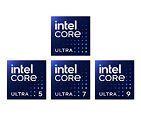


To begin with, Intel's brand regulation will no longer include the generational string (eg: 12th Gen Core or 13th Gen Core), since the generation is already part of the model number. Next up, the brand extension "i" is about to be dropped. Core i7, for example, will become simply Core 7. If we were to apply the new naming scheme on the "13th Gen Intel Core i7-13900," for example, it would be called simply "Intel Core 7-13900."

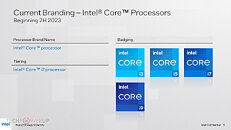

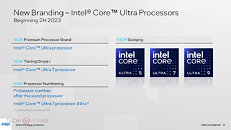
Intel is also introducing the new Core Ultra brand. This was probably done to deal with the overlap of a significantly newer architecture with an older architecture already being in the market, wherein Intel wouldn't want to retire the older architecture. Toward late 2023 or early 2024, Intel will be faced with having to market both processors based on the "Raptor Lake" architecture (which is rumored to be getting a major product-stack refresh in 2H-2023), and the upcoming "Meteor Lake" architecture. When Intel's Core Ultra branding takes effect, customers will be able to tell "Meteor Lake" based SKUs apart from those based on "Raptor Lake," but looking for the Ultra brand.
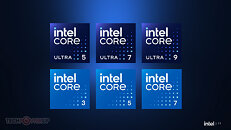

The Ultra brand extension could hence allow Intel to gracefully transition the market between processor architecture generations, and improve inventory digestion in the channel for the outgoing architecture. The main Core branding now includes three tiers—Core 3, Core 5, and Core 7. The Core Ultra brand includes the tiers Core Ultra 5, Core Ultra 7, and Core Ultra 9. The Ultra branding allows Intel to position certain enthusiast-grade SKUs within a generation (possibly Unlocked K/KF) with the Core Ultra brand.
The new branding will take effect around the time Intel launches its next-generation "Meteor Lake" microarchitecture, with its first SKUs debuting within the second half of 2023.
"Our client roadmap demonstrates how Intel is prioritizing innovation and technology leadership with products like Meteor Lake, focused on power efficiency and AI at scale. To better align with our product strategies, we are introducing a branding structure that will help PC buyers better differentiate the best of our latest technology and our mainstream offerings," said Caitlin Anderson, Intel vice president and general manager of Client Computing Group Sales.

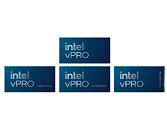

Intel also announced new case badge designs for Intel Evo, the company's premium thin-and-light notebook design specification brand, and the vPro brand that the company uses for its commercial desktop and commercial notebook processors. For consumer notebooks that need outer box labeling of the brand of processor and graphics powering it, Intel developed two additional badges.
View at TechPowerUp Main Site
The current Intel naming scheme sees the company mention processor generation before the main brand Core. For example, the 13th Gen Core is Intel's current line of client-segment products. Right next to Core, Intel places the brand extension "i" followed by the product tiering number 3, 5, 7, or 9. The product model number follows, and even this model number tends to begin with the processor generation. For example, the "i9-13900" already conveys that it is a processor from Intel's 13th Gen Core family. This is where Intel is making its two main changes.




To begin with, Intel's brand regulation will no longer include the generational string (eg: 12th Gen Core or 13th Gen Core), since the generation is already part of the model number. Next up, the brand extension "i" is about to be dropped. Core i7, for example, will become simply Core 7. If we were to apply the new naming scheme on the "13th Gen Intel Core i7-13900," for example, it would be called simply "Intel Core 7-13900."




Intel is also introducing the new Core Ultra brand. This was probably done to deal with the overlap of a significantly newer architecture with an older architecture already being in the market, wherein Intel wouldn't want to retire the older architecture. Toward late 2023 or early 2024, Intel will be faced with having to market both processors based on the "Raptor Lake" architecture (which is rumored to be getting a major product-stack refresh in 2H-2023), and the upcoming "Meteor Lake" architecture. When Intel's Core Ultra branding takes effect, customers will be able to tell "Meteor Lake" based SKUs apart from those based on "Raptor Lake," but looking for the Ultra brand.


The Ultra brand extension could hence allow Intel to gracefully transition the market between processor architecture generations, and improve inventory digestion in the channel for the outgoing architecture. The main Core branding now includes three tiers—Core 3, Core 5, and Core 7. The Core Ultra brand includes the tiers Core Ultra 5, Core Ultra 7, and Core Ultra 9. The Ultra branding allows Intel to position certain enthusiast-grade SKUs within a generation (possibly Unlocked K/KF) with the Core Ultra brand.
The new branding will take effect around the time Intel launches its next-generation "Meteor Lake" microarchitecture, with its first SKUs debuting within the second half of 2023.
"Our client roadmap demonstrates how Intel is prioritizing innovation and technology leadership with products like Meteor Lake, focused on power efficiency and AI at scale. To better align with our product strategies, we are introducing a branding structure that will help PC buyers better differentiate the best of our latest technology and our mainstream offerings," said Caitlin Anderson, Intel vice president and general manager of Client Computing Group Sales.



Intel also announced new case badge designs for Intel Evo, the company's premium thin-and-light notebook design specification brand, and the vPro brand that the company uses for its commercial desktop and commercial notebook processors. For consumer notebooks that need outer box labeling of the brand of processor and graphics powering it, Intel developed two additional badges.
View at TechPowerUp Main Site






 I'd immediately follow up on that with an overemphasized ULTRA muhahaha
I'd immediately follow up on that with an overemphasized ULTRA muhahaha
